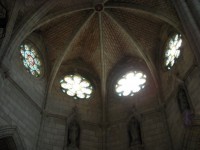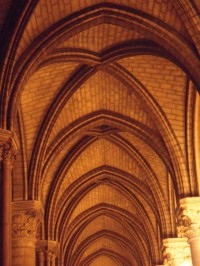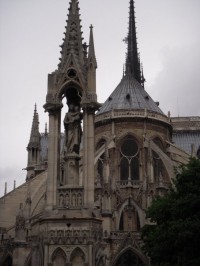France is home to some of Europe’s loveliest cathedrals. One of the best educational moves I ever made was to take a European art history course (that focused mostly on sacred architecture) before my first stint in France on a study abroad program. Seeing as that was over 10 years ago, I don’t remember nearly as much about it as I’d like to. However, thanks in part to the fact that I’m a fan of guided cathedral tours (and am notorious for dragging my fellow travelers along with me on them), I can still tell the difference between Gothic and Romanesque elements. Can you?!
If you answered yes, well, I’m sure you could teach me a thing or two. If you answered no, consider this your “crash course.”
Romanesque
 Historians typically site the Romanesque period as lasting from approximately 800 A.D. to 1100 A.D. However, the term “Romanesque” was coined much later, in 1818 to be exact, by Charles-Alexis-Adrien de Gerville and used to describe architecture of the 1800s. This was a result of the similarities between the barrel vault found in Romanesque cathedrals and the Roman arch (from the original Romanesque period). Romanesque architecture also shows influences from Visigothic, Carolingian, Byzantine and Islamic styles.
Historians typically site the Romanesque period as lasting from approximately 800 A.D. to 1100 A.D. However, the term “Romanesque” was coined much later, in 1818 to be exact, by Charles-Alexis-Adrien de Gerville and used to describe architecture of the 1800s. This was a result of the similarities between the barrel vault found in Romanesque cathedrals and the Roman arch (from the original Romanesque period). Romanesque architecture also shows influences from Visigothic, Carolingian, Byzantine and Islamic styles.
During the 19th century, Christians throughout Europe began making pilgrimages to visit the relics of favorite saints. Leaders of the church soon discovered that the basilica style of church was inadequate (in terms of space) for welcoming these travelers. So, they started constructing churches in the shape of a cross, in cruciform, to accommodate visits. Visitors would enter through the nave and proceed up to the crossing (the horizontal part of the “cross”), which was directly in front of the altar. The relics were kept in or near the altar, therefore this cross shape allowed for a natural flow of tourist traffic.
Gothic
 Gothic architecture evolved from the Romanesque style and flourished during the high and late medieval periods. It originated in France in the 12th century and lasted until the 16th century. It is often referred to as “The French Style,” or Opus Francigenum in Latin.
Gothic architecture evolved from the Romanesque style and flourished during the high and late medieval periods. It originated in France in the 12th century and lasted until the 16th century. It is often referred to as “The French Style,” or Opus Francigenum in Latin.
 You can spot a Gothic cathedral by its flying buttresses and high spires. It is important to note that not all Gothic architecture dates from the 12th-16th centuries. In fact, a period of Gothic revival began in mid-18th century (primarily in England) and continued into the 20th century throughout Europe.
You can spot a Gothic cathedral by its flying buttresses and high spires. It is important to note that not all Gothic architecture dates from the 12th-16th centuries. In fact, a period of Gothic revival began in mid-18th century (primarily in England) and continued into the 20th century throughout Europe.
In some regions of France, Romanesque-style churches continued to be built well into the 13th century. There was also quite a bit of overlap between the two styles; these features are often referred to as “transitional.”
Now it’s time to test your knowledge “in the field” (what a great excuse to take a trip) and impress your fellow travelers. To help you plan your tour, here is a llink to a list of some of France’s most famous and most beautiful cathedrals: Cathedrals in France (including style descriptions, so you can read up ahead of time)


Comments